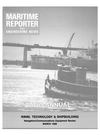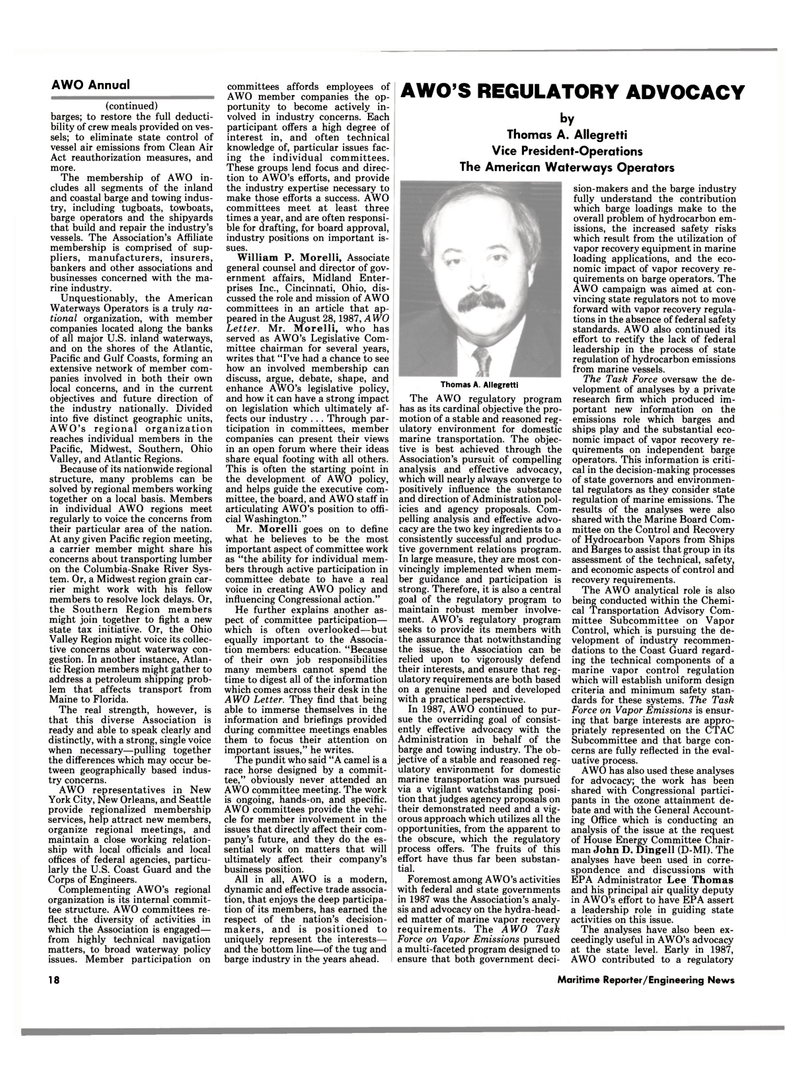
Page 16: of Maritime Reporter Magazine (March 1988)
Read this page in Pdf, Flash or Html5 edition of March 1988 Maritime Reporter Magazine
AWO Annual (continued) barges; to restore the full deducti- bility of crew meals provided on ves- sels; to eliminate state control of vessel air emissions from Clean Air
Act reauthorization measures, and more.
The membership of AWO in- cludes all segments of the inland and coastal barge and towing indus- try, including tugboats, towboats, barge operators and the shipyards that build and repair the industry's vessels. The Association's Affiliate membership is comprised of sup- pliers, manufacturers, insurers, bankers and other associations and businesses concerned with the ma- rine industry.
Unquestionably, the American
Waterways Operators is a truly na- tional organization, with member companies located along the banks of all major U.S. inland waterways, and on the shores of the Atlantic,
Pacific and Gulf Coasts, forming an extensive network of member com- panies involved in both their own local concerns, and in the current objectives and future direction of the industry nationally. Divided into five distinct geographic units,
AWO's regional organization reaches individual members in the
Pacific, Midwest, Southern, Ohio
Valley, and Atlantic Regions.
Because of its nationwide regional structure, many problems can be solved by regional members working together on a local basis. Members in individual AWO regions meet regularly to voice the concerns from their particular area of the nation.
At any given Pacific region meeting, a carrier member might share his concerns about transporting lumber on the Columbia-Snake River Sys- tem. Or, a Midwest region grain car- rier might work with his fellow members to resolve lock delays. Or, the Southern Region members might join together to fight a new state tax initiative. Or, the Ohio
Valley Region might voice its collec- tive concerns about waterway con- gestion. In another instance, Atlan- tic Region members might gather to address a petroleum shipping prob- lem that affects transport from
Maine to Florida.
The real strength, however, is that this diverse Association is ready and able to speak clearly and distinctly, with a strong, single voice when necessary—pulling together the differences which may occur be- tween geographically based indus- try concerns.
AWO representatives in New
York City, New Orleans, and Seattle provide regionalized membership services, help attract new members, organize regional meetings, and maintain a close working relation- ship with local officials and local offices of federal agencies, particu- larly the U.S. Coast Guard and the
Corps of Engineers.
Complementing AWO's regional organization is its internal commit- tee structure. AWO committees re- flect the diversity of activities in which the Association is engaged— from highly technical navigation matters, to broad waterway policy issues. Member participation on committees affords employees of
AWO member companies the op- portunity to become actively in- volved in industry concerns. Each participant offers a high degree of interest in, and often technical knowledge of, particular issues fac- ing the individual committees.
These groups lend focus and direc- tion to AWO's efforts, and provide the industry expertise necessary to make those efforts a success. AWO committees meet at least three times a year, and are often responsi- ble for drafting, for board approval, industry positions on important is- sues.
William P. Morelli, Associate general counsel and director of gov- ernment affairs, Midland Enter- prises Inc., Cincinnati, Ohio, dis- cussed the role and mission of AWO committees in an article that ap- peared in the August 28, 1987, AWO
Letter. Mr. Morelli, who has served as AWO's Legislative Com- mittee chairman for several years, writes that "I've had a chance to see how an involved membership can discuss, argue, debate, shape, and enhance AWO's legislative policy, and how it can have a strong impact on legislation which ultimately af- fects our industry . .. Through par- ticipation in committees, member companies can present their views in an open forum where their ideas share equal footing with all others.
This is often the starting point in the development of AWO policy, and helps guide the executive com- mittee, the board, and AWO staff in articulating AWO's position to offi- cial Washington."
Mr. Morelli goes on to define what he believes to be the most important aspect of committee work as "the ability for individual mem- bers through active participation in committee debate to have a real voice in creating AWO policy and influencing Congressional action."
He further explains another as- pect of committee participation— which is often overlooked—but equally important to the Associa- tion members: education. "Because of their own job responsibilities many members cannot spend the time to digest all of the information which comes across their desk in the
AWO Letter. They find that being able to immerse themselves in the information and briefings provided during committee meetings enables them to focus their attention on important issues," he writes.
The pundit who said "A camel is a race horse designed by a commit- tee," obviously never attended an
AWO committee meeting. The work is ongoing, hands-on, and specific.
AWO committees provide the vehi- cle for member involvement in the issues that directly affect their com- pany's future, and they do the es- sential work on matters that will ultimately affect their company's business position.
All in all, AWO is a modern, dynamic and effective trade associa- tion, that enjoys the deep participa- tion of its members, has earned the respect of the nation's decision- makers, and is positioned to uniquely represent the interests— and the bottom line—of the tug and barge industry in the years ahead.
AWO'S REGULATORY ADVOCACY by
Thomas A. Allegretti
Vice President-Operations
The American Waterways Operators sion-makers and the barge industry fully understand the contribution which barge loadings make to the overall problem of hydrocarbon em- issions, the increased safety risks which result from the utilization of vapor recovery equipment in marine loading applications, and the eco- nomic impact of vapor recovery re- quirements on barge operators. The
AWO campaign was aimed at con- vincing state regulators not to move forward with vapor recovery regula- tions in the absence of federal safety standards. AWO also continued its effort to rectify the lack of federal leadership in the process of state regulation of hydrocarbon emissions from marine vessels.
The Task Force oversaw the de- velopment of analyses by a private research firm which produced im- portant new information on the emissions role which barges and ships play and the substantial eco- nomic impact of vapor recovery re- quirements on independent barge operators. This information is criti- cal in the decision-making processes of state governors and environmen- tal regulators as they consider state regulation of marine emissions. The results of the analyses were also shared with the Marine Board Com- mittee on the Control and Recovery of Hydrocarbon Vapors from Ships and Barges to assist that group in its assessment of the technical, safety, and economic aspects of control and recovery requirements.
The AWO analytical role is also being conducted within the Chemi- cal Transportation Advisory Com- mittee Subcommittee on Vapor
Control, which is pursuing the de- velopment of industry recommen- dations to the Coast Guard regard- ing the technical components of a marine vapor control regulation which will establish uniform design criteria and minimum safety stan- dards for these systems. The Task
Force on Vapor Emissions is ensur- ing that barge interests are appro- priately represented on the CTAC
Subcommittee and that barge con- cerns are fully reflected in the eval- uative process.
AWO has also used these analyses for advocacy; the work has been shared with Congressional partici- pants in the ozone attainment de- bate and with the General Account- ing Office which is conducting an analysis of the issue at the request of House Energy Committee Chair- man John D. Dingell (D-MI). The analyses have been used in corre- spondence and discussions with
EPA Administrator Lee Thomas and his principal air quality deputy in AWO's effort to have EPA assert a leadership role in guiding state activities on this issue.
The analyses have also been ex- ceedingly useful in AWO's advocacy at the state level. Early in 1987,
AWO contributed to a regulatory
Thomas A. Allegretti
The AWO regulatory program has as its cardinal objective the pro- motion of a stable and reasoned reg- ulatory environment for domestic marine transportation. The objec- tive is best achieved through the
Association's pursuit of compelling analysis and effective advocacy, which will nearly always converge to positively influence the substance and direction of Administration pol- icies and agency proposals. Com- pelling analysis and effective advo- cacy are the two key ingredients to a consistently successful and produc- tive government relations program.
In large measure, they are most con- vincingly implemented when mem- ber guidance and participation is strong. Therefore, it is also a central goal of the regulatory program to maintain robust member involve- ment. AWO's regulatory program seeks to provide its members with the assurance that notwithstanding the issue, the Association can be relied upon to vigorously defend their interests, and ensure that reg- ulatory requirements are both based on a genuine need and developed with a practical perspective.
In 1987, AWO continued to pur- sue the overriding goal of consist- ently effective advocacy with the
Administration in behalf of the barge and towing industry. The ob- jective of a stable and reasoned reg- ulatory environment for domestic marine transportation was pursued via a vigilant watchstanding posi- tion that judges agency proposals on their demonstrated need and a vig- orous approach which utilizes all the opportunities, from the apparent to the obscure, which the regulatory process offers. The fruits of this effort have thus far been substan- tial.
Foremost among AWO's activities with federal and state governments in 1987 was the Association's analy- sis and advocacy on the hydra-head- ed matter of marine vapor recovery requirements. The AWO Task
Force on Vapor Emissions pursued a multi-faceted program designed to ensure that both government deci- 18 Maritime Reporter/Engineering News

 15
15

 17
17
